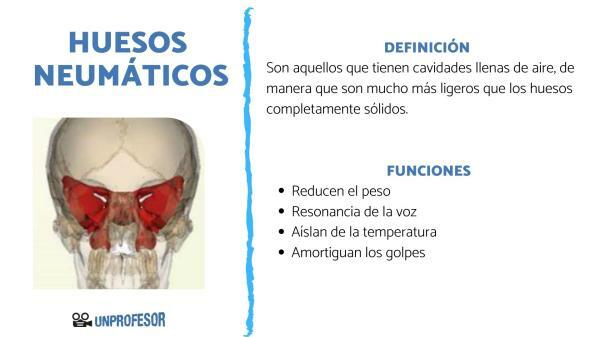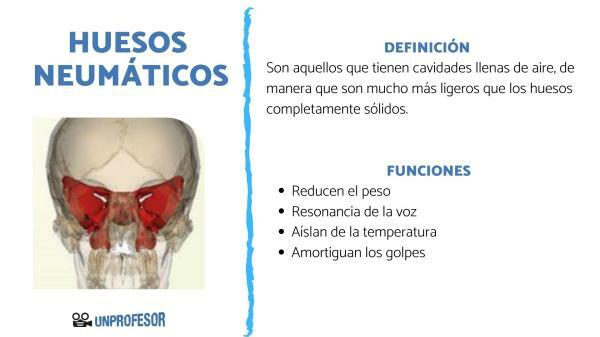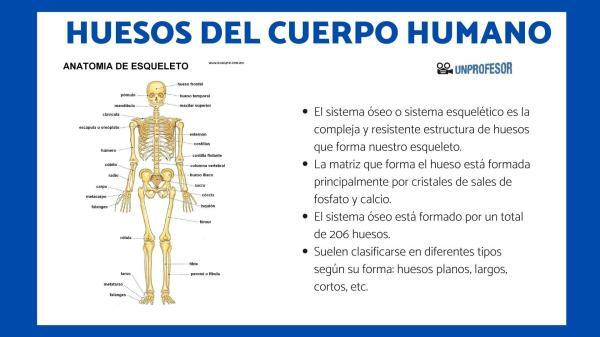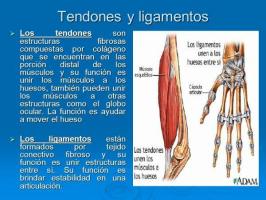What are PNEUMATIC bones and their function

pneumatic bones are those who house air filled cavities which results in a remarkable decrease in its weight compared to fully compact bones.
The bones They are the strong and rigid structures that we have in the body and that are composed of proteins and minerals such as calcium. Bones have a hard, dense outer layer that gives them strength. However, we have 206 bones in our body and each one of them is different, such as pneumatic bones.
In this lesson from a PROFESSOR, we want to explain in detail what are pneumatic bones and what is their function inside the human body, so that you understand a little better how our bone system works.
Pneumatic bones are those that have cavities filled with air, so they are much lighter than completely solid bones. The word PNEUMATIC refers to the air contained under pressure and finds its origin in the Greek, being directly related to concepts such as wind and breathing.
In biology, the word PNEUMATIC refers to breathing, so these bones are also known as the BREATHING BONES or HOLLOW BONES.
Birds are animals with pneumatic bones. very light weight and that is what has given them the ability to fly, thanks to their lightness.If we talk about humans, the facial bones are pneumatic. These are found around the inner brow, under the eyes, around the nose, and near the lower cheeks. These pneumatic bone cavities are lined on the inside by a layer of cells called epithelium, covered by mucosa.
These pneumatic bones allow the skull to be lighter and also aid in the resonance of sound. A curiosity is that mucosa is used to regulate temperature of the air that we inspire, before it reaches the lungs, since these are quite delicate organs.
This process of pneumatization of bones has been found in the mammal skull, in birds and crocodiles, but also in animals that are already extinct, such as dinosaurs.
It is important to note that not all bones of the face and skull are pneumatic. There are some bones, such as the nasal, lower jaw (mandible), and zygomatic (cheekbone) bone, that are massive, dense, and much more solid in structure.

Pneumatic cavities in bones have various functions and features that are worth highlighting, since they are the ones that give us many of our characteristics as a species:
reduce weight
As we have mentioned before, one of the main functions of pneumatic bones is that the air inside them allows reduce the weight of the structure, without affecting the resistance. This is very important in the skull and face, since they must maintain a light structure, but strong enough to protect the vital organs.
voice resonance
Some of the pneumatic bones, such as the frontal sinus and the maxillary sinus, are closely linked to the voice resonance. These air-filled cavities act as resonance chambers, modifying the sound and allowing us to speak in a high, projected tone.
insulate from temperature
The air found inside the pneumatic cavities of the bones acts as a thermal insulator. This serves to protect the internal structures from extreme cold or heat, since they act as a barrier against temperature changes.
They cushion the blows
Pneumatic bones function as cushioning structures, helping us to absorb and distribute impacts They can take place on the face or skull. This is vital for the protection of tissues and organs such as the brain or the eyes, which are very delicate and could suffer serious injuries.

We want to discover all types of human bones and their names. And it is that the human skeleton has 6 different types of bones, besides the tires and we are going to give you a brief explanation of each one of them, so that you can have a broader vision of our organism:
- sesamoid bones: They are small and are attached to the tendons. They have the function of facilitating movement. Their shape is round and they protect the joints, such as the kneecap.
- long bones: They are cylindrical in shape and are longer than they are wide, although they do not have to be large. Its main function is to support the weight of the body and facilitate movement. These bones can be found in the extremities, such as the femur, tibia, fibula, humerus, radius, ulna, etc.
- short bones: The short bones are those that are cube-shaped, since the width is approximately equal to the length and they are usually small. For example, we find them in the bones of the hands and feet, known as the carpal or tarsal bones.
- flat bones: Flat bones are the most abundant in the body and are thin, with little thickness and a large surface area. These types of bones are the ones that cover the organs and their shape can be reminiscent of a shield. For example: the bones of the skull, the rib cage and the pelvis.
- irregular bones: These are the ones that have different shapes and characteristics, since they adapt perfectly to the area in which they are located or to the function they must fulfill. Some examples are the vertebrae of the spinal column or the ossicles of the inner ear.
- accessory bones: Not everyone has accessory bones and they are only found when the person sustains an injury. These bones appear or disappear hereditary, that is, if one of the parents lacks a bone, the child will not have it either. Some of these bones are the trigone (located behind the ankle) and the fabella (which is embedded in the tendon behind the knee).
Now you know what are pneumatic bones and what is its function within the human body. If you want to continue delving into this topic or a similar one, do not hesitate to consult our section on biology and leave us a comment, as we would love to know what you think about science natural.




